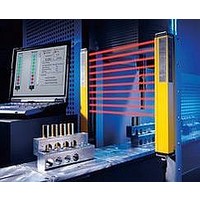F39-EU1E Omron, F39-EU1E Datasheet - Page 810

F39-EU1E
Manufacturer Part Number
F39-EU1E
Description
F3S-B OPTIONAL PROGRAMMING KIT
Manufacturer
Omron
Datasheet
1.F39-EU1E.pdf
(865 pages)
Specifications of F39-EU1E
Leaded Process Compatible
No
Peak Reflow Compatible (260 C)
No
Light Curtain Type
Safety
Lead Free Status / RoHS Status
Contains lead / RoHS non-compliant
Lead Free Status / RoHS Status
Contains lead / RoHS non-compliant
- Current page: 810 of 865
- Download datasheet (35Mb)
Courtesy of Steven Engineering, Inc.-230 Ryan Way, South San Francisco, CA 94080-6370-Main Office: (650) 588-9200-Outside Local Area: (800) 258-9200-www.stevenengineering.com
Safety Precautions
Refer to “Regulations and Standards” and “Safety Precautions” for F3SN-A/F3SN-B/F3SH-A.
“Type Certification” specified in the Chapter 44. 2 of the Industrial Safety and Health Law in Japan does not apply to independent F3SS Sensors.
This law applies to systems incorporating the Sensor. When using the F3SL Sensor in Japan as a “safety device for presses or shearing machines,”
as specified in the Chapter 42 of the same law, apply for certification for the overall system.
Detection Zone and Intrusion Path
Refer to “Precautions for All Safety Sensors” for the installation
conditions of Safety Light Curtains.
·
Safety Distance
Install protective structures in all parts of the detection
zone where detection is disabled by the fixed blanking
function so no one can pass through the detection zone
to reach the hazardous part of the machine. Failure to do
so may result in serious injury.
Always maintain a safety distance (S) between the Light
Curtain and a hazardous part of a machine.
Failure to do so may prevent the machine from stopping
before an operator reaches the dangerous area and may
result in serious injury.
Floating blanking is used to increase the minimum
detectable object size. Be sure to use the minimum
detectable object size for floating blanking when
calculating safety distance. Failure to do so may prevent
the machine from stopping before an operator reaches
the dangerous area and may result in serious injury.
Refer to F3SN-A/F3SN-B/F3SH-A for examples of calculating the
safety distance.
Use of the Fixed Blanking Function
http://www.ia.omron.com/
!WARNING
Do not used the product in atmospheres or environments that exceed
product ratings.
Installation
How to Prevent Mutual Interference
Series Connections (Up to 3 sets, 240 beams, Sensor
models ending in -01 and -04 are required for series
connection)
Two or more pairs of the F3SN-A@SS can be connected in series.
When connected in series, the F3SN-A@SS Sensors generate
beams in a time-sharing manner to prevent mutual interference and
ensure safety.
When Not Connected in Series
Refer to “Precautions for All Safety Sensors” for information on
preventing mutual interference of Safety Light Curtains that are not
connected in series.
Special
connecting cable
F39-JCR2B or
F39-JCR5B or
F39-JC3B
(c)Copyright OMRON Corporation 2007 All Rights Reserved.
Receiver 2
Emitter 2
Emitter 1
Emitter 1
Do not connect the Emitter and
Receiver in series, or a lockout
condition will result.
Precautions for Correct Use
Incorrect
Correct
Receiver 2
Receiver 1
Receiver 1
Emitter 2
Emitter 1
Emitter 2
Do not combine an Emitter with a
Receiver of a different pair.
This will cause a lockout condition
and detection of objects will be
disabled.
F3SN-A@SS
Emitter
Incorrect
Receiver 2
Receiver 1
Receiver
21
Related parts for F39-EU1E
Image
Part Number
Description
Manufacturer
Datasheet
Request
R

Part Number:
Description:
Pair Of Flat Mounting Brackets (transmitter & Receiver)
Manufacturer:
Omron

Part Number:
Description:
Pair Of Protective Shrouds (transmitter & Receiver)
Manufacturer:
Omron

Part Number:
Description:
G6S-2GLow Signal Relay
Manufacturer:
Omron Corporation
Datasheet:

Part Number:
Description:
Compact, Low-cost, SSR Switching 5 to 20 A
Manufacturer:
Omron Corporation
Datasheet:

Part Number:
Description:
Manufacturer:
Omron Corporation
Datasheet:










